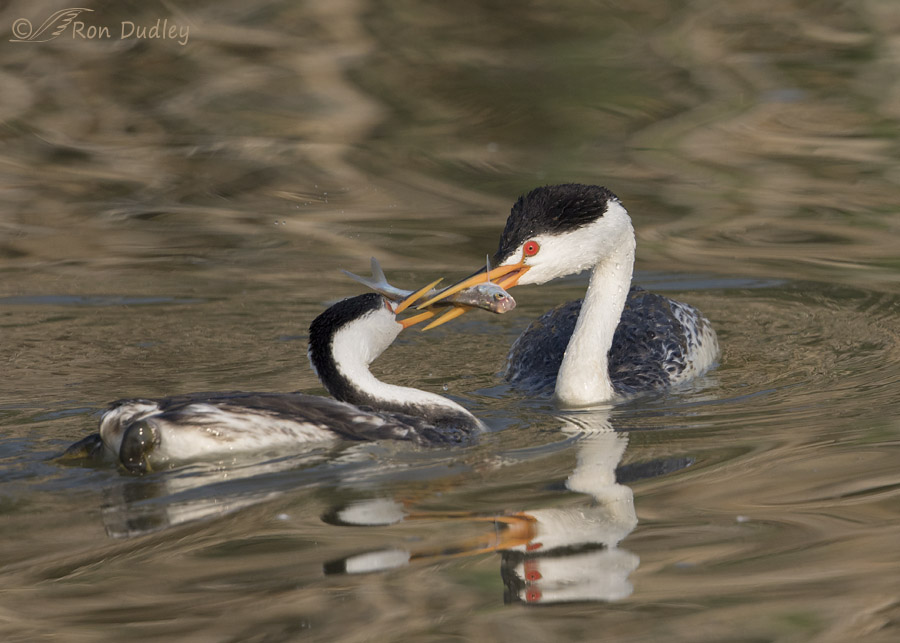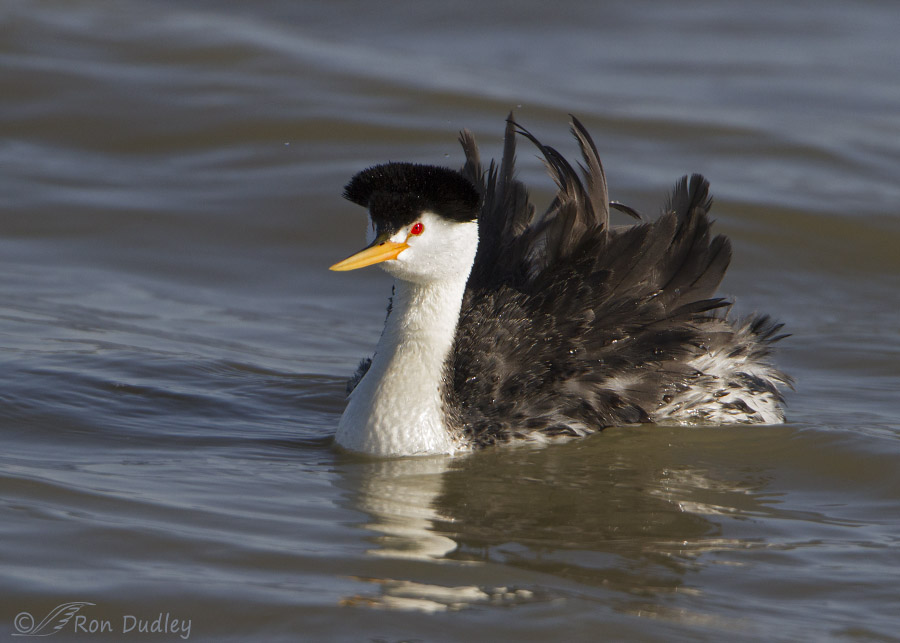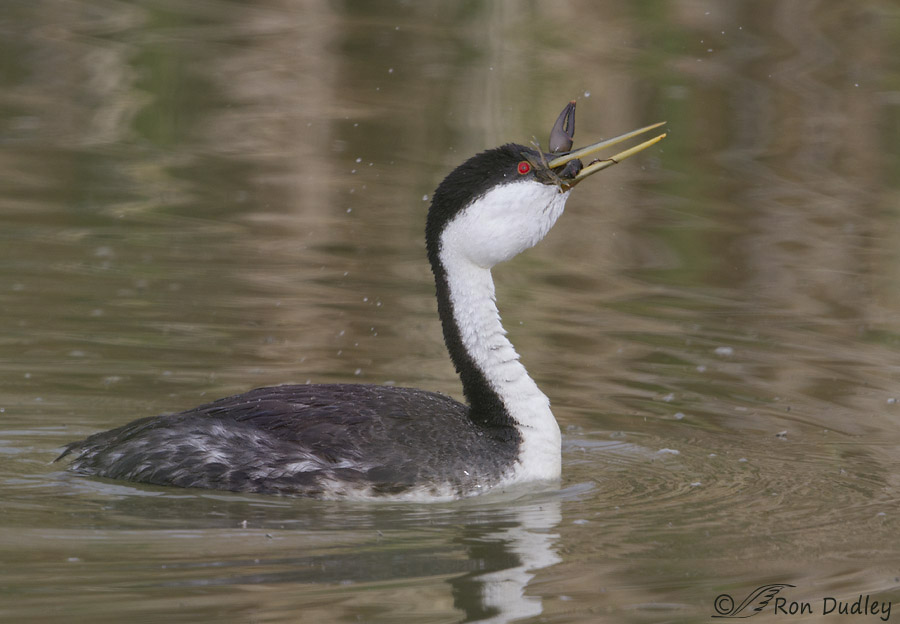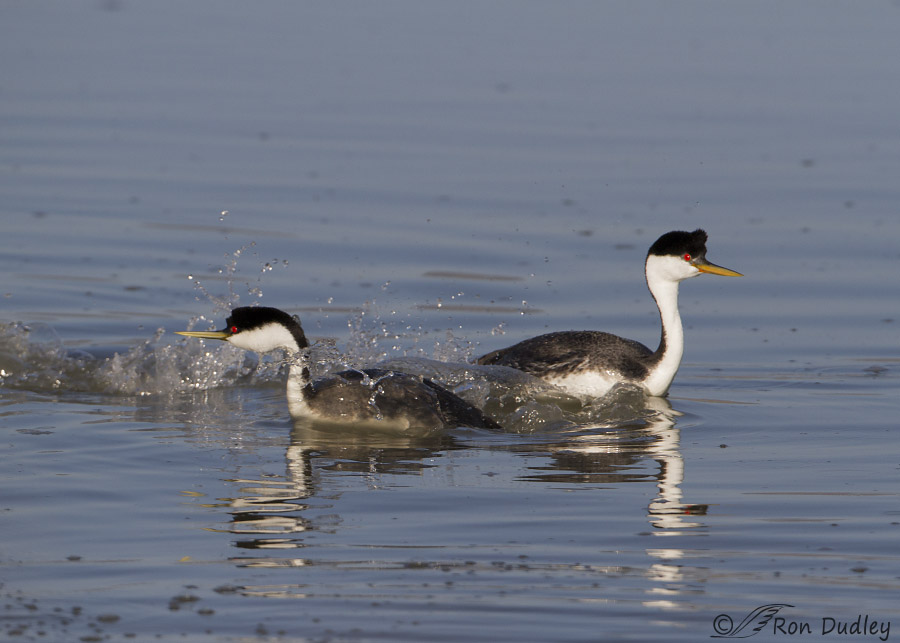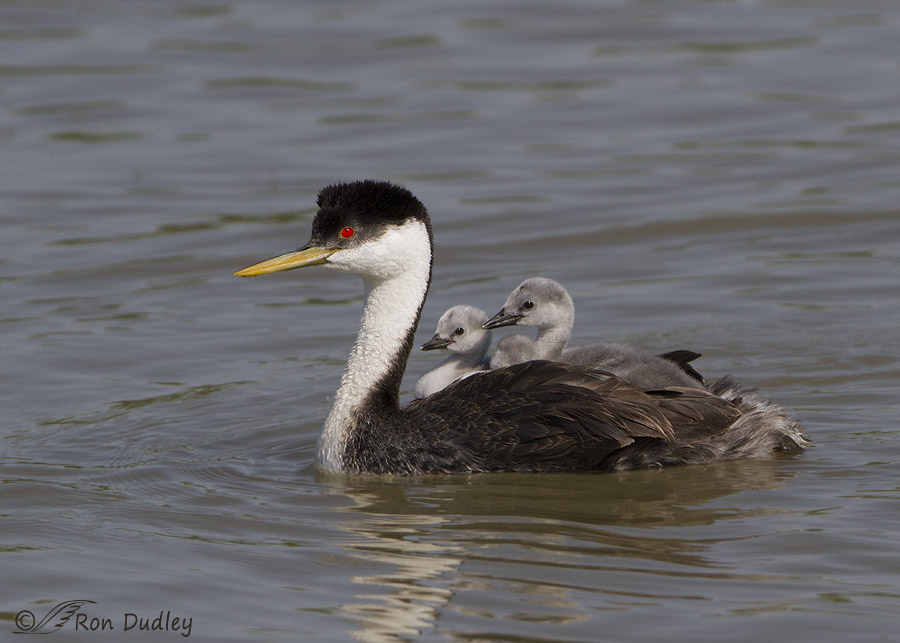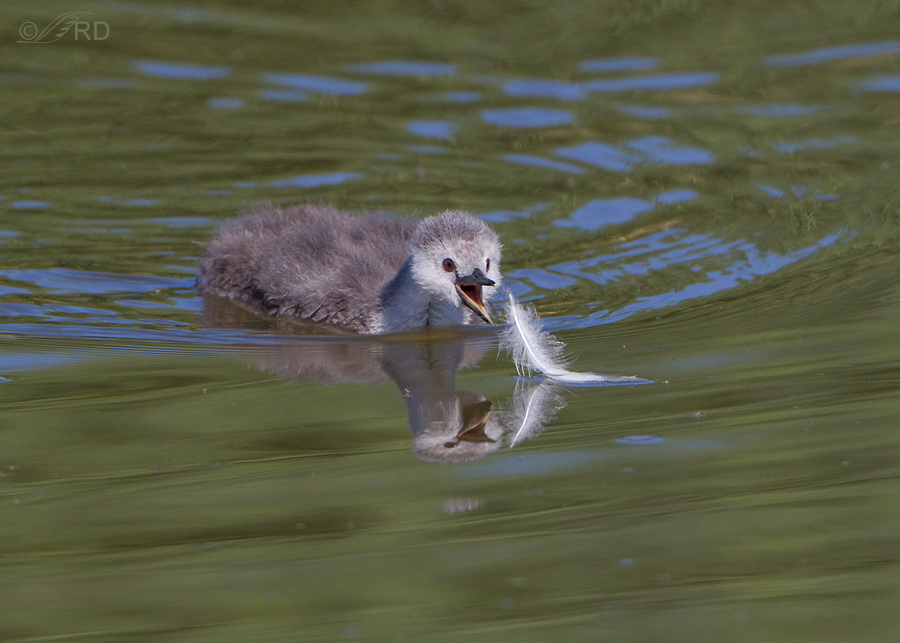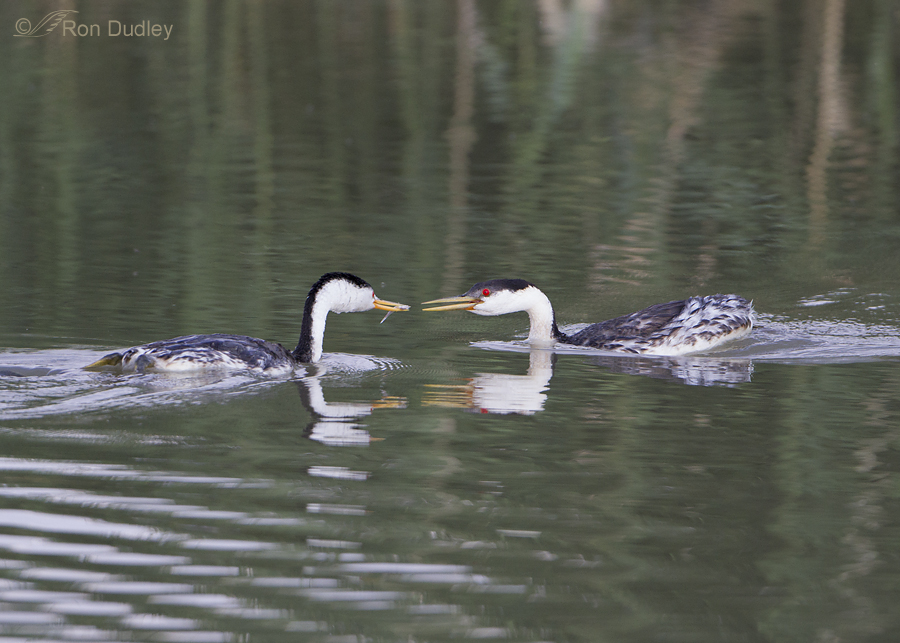Tag: clarks grebe
Clark’s/Western Grebe Crests
Western Grebe Swallowing A Crayfish
An Aggressive Western Grebe (and a difference in water-running style among grebe species)
Grebe Chicks Hitchin’ A Ride
Grebes Eating Feathers (including two graphic images)
Western And Clark’s Grebes – A Comparison
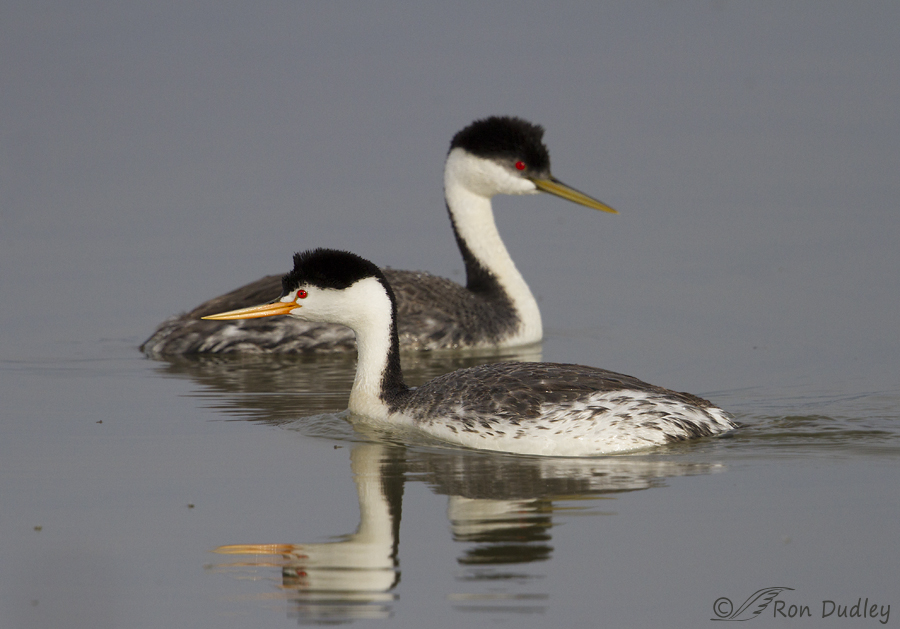
Western Grebes and Clark’s Grebes are so similar in plumage patterns and behaviors that until 1985 they were considered to be color phases of the same species – the Western Grebe. In fact they’re similar enough that many observers never even recognize Clark’s Grebes when they see them and assume that they’re the more common Western Grebe.
Western Grebe Mated With Clark’s Grebe
Clark’s Grebe Blowin’ In The Wind
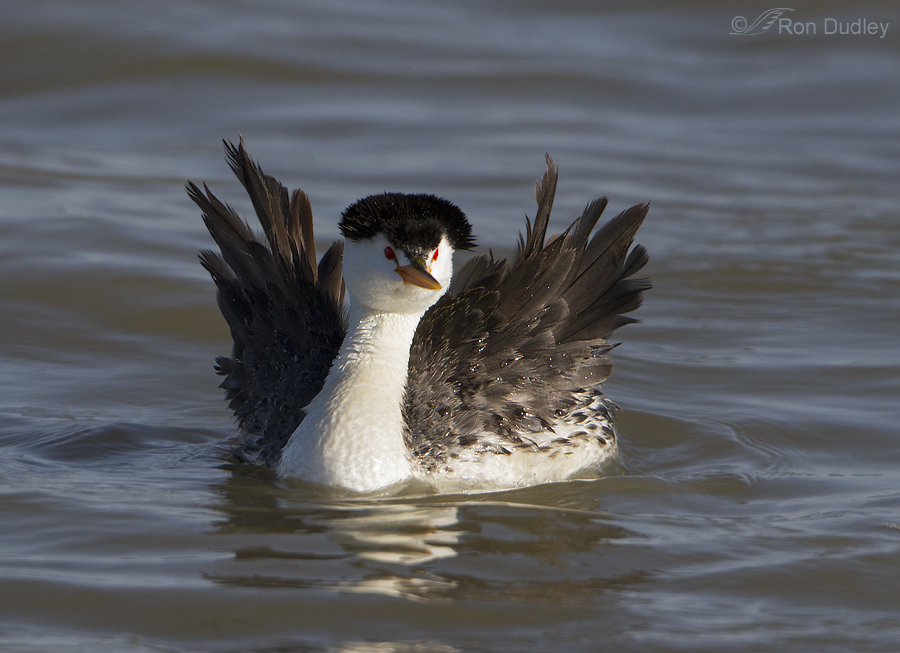
Three days ago at Bear River Migratory Bird refuge I had some wind to contend with as I was photographing this Clark’s Grebe. It made the water a little choppy and would occasionally ruffle the feathers of one of the birds when it turned its back to the breeze.
The effect varied fairly dramatically.
Clark’s Grebes – Parents Feeding Fish To Some Very Excited Chicks
This past June I spent lots of time with Western and Clark’s Grebes as they were raising their families. The two species are quite similar but the adult birds in this post can be recognized as Clark’s Grebes by their bright yellow-orange bills and the fact that their eyes are surrounded by white plumage, rather than black. 1/2000. f/7.1, ISO 500, 500 f/4, 1.4 tc, natural light This female of a mated pair was fishing for her family as the male back-brooded two chicks (the sexes take turns with each role). I happened to catch her just as she emerged from the water with a fish and shook the water off. I wish I had better eye contact and more room around the grebe, but this image is full frame. I include it here because it’s the logical beginning of this “fish story”. 1/2000. f/8, ISO 500, 500 f/4, 1.4 tc, natural light Seconds later she swam over to deliver the fish to her family. Sometimes the fish will be given to the brooding parent, who may eat it or give it to a chick. Other times, the fishing parent gives it directly to one of the youngsters. Either way, if the chicks are hungry they become very excited and aggressive in their attempts to be the one who gets the fish. Before the young birds saw breakfast coming their way, they were tucked down peacefully under each wing with only their heads and necks sticking out. All that changed in an instant. 1/2000….
Western Grebes Dumping Their Chicks
I haven’t posted for a few days because I’ve been in Montana for most of the past week. I have many images from that trip and hopefully some of them will appear here in the near future. But for now I’d like to report on another grebe behavior I photographed recently. This time it will be the Western Grebe, rather than the Clark’s Grebes in two of my recent posts. The two species are very similar and most easily distinguished by differences in bill color (Clark’s is bright yellow to orange-yellow while the Western’s bill is yellow to dull olive colored) and coloration around the eye (Clark’s is white surrounding the eye while the Western is dark around the eye). Both species rarely fly except during migration. In fact for much of the year they are incapable of flight because their flight muscles atrophy soon after arriving at their breeding grounds. So it’s my working theory that this might explain part of the reason why these grebes do so much wing flapping and stretching while sitting on the surface of the water – to excercise their relatively unused wings. Note: In many of these images I was too close to the birds to get an aesthetically pleasing composition so in most cases the birds will be too tight in the frame. But I think they show well the behavior I’m describing. 1/2000, f/10, ISO 500, 500 f/4, 1.4 tc This Western Grebe is in the middle of a wing-flap. They look so lithe and streamlined while…
Clark’s Grebe Chicks Competing For Food
One of the Clark’s Grebe behaviors I was able to photograph last week was the adults feeding their chicks. The youngsters would be on the back of one parent while the other one brought in fish for breakfast. They were always small fish, to accommodate the very young chicks. Some of these aren’t great photos but collectively I think they tell an interesting story. I had been shooting faster action just prior to this sequence so my settings for the first shot aren’t particularly appropriate but then I quickly adjusted. 1/4000, f/6.3, ISO 640, 500 f/4, 1.4 tc The parent bringing in the fish wouldn’t give them directly to the chicks but instead would hand them off to its mate and then that bird would feed the youngsters on its back. Here the parent on the left has just given this small fish to the brooding adult. 1/2500, f/8, ISO 640, 500 f/4, 1.4 tc The chick in the water knew it had no chance to get the fish while it was there so it immediately made a bee-line for the back of its parent. When they’re this size they still struggle to get on board. Sometimes the parent sticks a leg out backward for the chick to climb up on but this youngster was on its own and was frantic to get up front where the food would be doled out. 1/2500, f/8, ISO 640, 500 f/4, 1.4 tc I imagine it’s not easy getting up there since they have to work against the grain of the feathers of the…
Can’t We Go Any Faster Dad?
I’ll preface this post with an apology for the cutesy title. I usually avoid them at all costs but in this case I just couldn’t help myself… (I’m making the assumption that the adult bird here is the male because of its straight bill but it’s a subtle distinction and I could be wrong). For the last few days we’ve been having a great time with Clark’s and Western Grebes and their chicks. Both sexes of both species brood their chicks on their backs (back brooding) from almost the moment they hatch until they are quite large. I’ve seen up to three chicks of about this size on the back of a single adult, although by the time they get this size the other parent often shares the burden. 1/1600, f/8, ISO 400, 500 f/4, 1.4 tc When I first saw this image of a Clark’s Grebe and its chick on my screen I assumed it was simply another case of the youngster having just jumped onto the back of the adult (as evidenced by the position of the feet and the direction of the water splash). But now I’m quite convinced that the adult was actually allowing the youngster to act as an outboard motor of sorts as the chick seems to be providing the propulsion as the parent relaxes. If so, and I think it is, in all the time I’ve spent watching these birds this is the first time I’ve noticed such interesting behavior. I offer this image as further evidence of my theory…
A Mixed Bag Of Recent Birds
These images were all taken over the last eight days, either at Bear River Migratory Bird Refuge or Antelope Island. Another one of my “potpourri” posts with no common theme except “feathers”. 1/640, f/7.1, ISO 640, 500 f/4 The Willets have finally come up on the island for their mating activities (as opposed to the shoreline for recuperation after migration) and I like to try to catch them perched high on the sagebrush where they call loudly to other Willets. 1/2500, f/6.3, ISO 500, 500 f/4, 1.4 tc Western Meadowlarks are in their glory right now and their distinctive songs reverberate all over the island. 1/5000, f/6.3, ISO 500, 500 f/4, 1.4 tc I got closer to this one than I usually can. 1/1600, f/7.1, ISO 500, 500 f/4 This Loggerhead Shrike was grooming peacefully when I noticed a distinct change in its behavior. 1/1250, f/7.1, ISO 500, 500 f/4 A Common Raven flew low overhead and this was the shrike’s reaction. It flattened its body out almost into a bullet shape and pointed that bullet at the raven as it passed. I’m guessing it was an instinctive behavior to present the smallest profile possible to a larger bird that might be a potential threat. It was comical to watch it turn as the raven flew by to keep its body pointed in the larger birds direction. 1/2000, f/6.3, ISO 500, 500 f/4, 1.4 tc I’m always happy to catch a Chukar perched on a boulder, especially when it isn’t one of the…
Why Grebes Eat Feathers
Grebes, as a group, are known for eating feathers – usually their own. The obvious question is – why? There would be virtually no nutritional value in a feather. Clark’s Grebe eating a feather I’ve photographed four species of grebes – Western Grebe, Clarks Grebe (these two are very similar), Pied-billed Grebe and Eared Grebe. I’ve been able to document feather eating in all but the Eared Grebe. Western Grebe parent feeding feather to young Over a period of perhaps a half hour I watched this adult feed several feathers to the chicks, who seemed almost as eager to consume the feathers as they did the fish provided by the parents. Western Grebe chick reaching for a feather from its parent Feathers are fed to the young almost immediately after hatching. In fact, feathers are very often the first item eaten by newly hatched chicks of many grebe species. The purpose(s) of feather eating is unproven but evidence suggests that the behavior has these benefits for the birds. Some of the ingested feathers form a plug in the pylorus, between the stomach and small intestine, which acts as a strainer to keep fish bones in the stomach long enough to be completely digested. Most swallowed feathers end up in the stomach lumen, mixed with food. They eventually (along with any indigestible matter) form pellets that are ejected through the mouth. The continuous passage of these pellets through the upper digestive system minimizes the buildup of a variety of parasites that are very common there and plague grebes. Pied-billed…
Clark’s/Western Grebe Crests
Western Grebe Swallowing A Crayfish
An Aggressive Western Grebe (and a difference in water-running style among grebe species)
Grebe Chicks Hitchin’ A Ride
Grebes Eating Feathers (including two graphic images)
Western And Clark’s Grebes – A Comparison

Western Grebes and Clark’s Grebes are so similar in plumage patterns and behaviors that until 1985 they were considered to be color phases of the same species – the Western Grebe. In fact they’re similar enough that many observers never even recognize Clark’s Grebes when they see them and assume that they’re the more common Western Grebe.
Western Grebe Mated With Clark’s Grebe
Clark’s Grebe Blowin’ In The Wind

Three days ago at Bear River Migratory Bird refuge I had some wind to contend with as I was photographing this Clark’s Grebe. It made the water a little choppy and would occasionally ruffle the feathers of one of the birds when it turned its back to the breeze.
The effect varied fairly dramatically.
Clark’s Grebes – Parents Feeding Fish To Some Very Excited Chicks
This past June I spent lots of time with Western and Clark’s Grebes as they were raising their families. The two species are quite similar but the adult birds in this post can be recognized as Clark’s Grebes by their bright yellow-orange bills and the fact that their eyes are surrounded by white plumage, rather than black. 1/2000. f/7.1, ISO 500, 500 f/4, 1.4 tc, natural light This female of a mated pair was fishing for her family as the male back-brooded two chicks (the sexes take turns with each role). I happened to catch her just as she emerged from the water with a fish and shook the water off. I wish I had better eye contact and more room around the grebe, but this image is full frame. I include it here because it’s the logical beginning of this “fish story”. 1/2000. f/8, ISO 500, 500 f/4, 1.4 tc, natural light Seconds later she swam over to deliver the fish to her family. Sometimes the fish will be given to the brooding parent, who may eat it or give it to a chick. Other times, the fishing parent gives it directly to one of the youngsters. Either way, if the chicks are hungry they become very excited and aggressive in their attempts to be the one who gets the fish. Before the young birds saw breakfast coming their way, they were tucked down peacefully under each wing with only their heads and necks sticking out. All that changed in an instant. 1/2000….
Western Grebes Dumping Their Chicks
I haven’t posted for a few days because I’ve been in Montana for most of the past week. I have many images from that trip and hopefully some of them will appear here in the near future. But for now I’d like to report on another grebe behavior I photographed recently. This time it will be the Western Grebe, rather than the Clark’s Grebes in two of my recent posts. The two species are very similar and most easily distinguished by differences in bill color (Clark’s is bright yellow to orange-yellow while the Western’s bill is yellow to dull olive colored) and coloration around the eye (Clark’s is white surrounding the eye while the Western is dark around the eye). Both species rarely fly except during migration. In fact for much of the year they are incapable of flight because their flight muscles atrophy soon after arriving at their breeding grounds. So it’s my working theory that this might explain part of the reason why these grebes do so much wing flapping and stretching while sitting on the surface of the water – to excercise their relatively unused wings. Note: In many of these images I was too close to the birds to get an aesthetically pleasing composition so in most cases the birds will be too tight in the frame. But I think they show well the behavior I’m describing. 1/2000, f/10, ISO 500, 500 f/4, 1.4 tc This Western Grebe is in the middle of a wing-flap. They look so lithe and streamlined while…
Clark’s Grebe Chicks Competing For Food
One of the Clark’s Grebe behaviors I was able to photograph last week was the adults feeding their chicks. The youngsters would be on the back of one parent while the other one brought in fish for breakfast. They were always small fish, to accommodate the very young chicks. Some of these aren’t great photos but collectively I think they tell an interesting story. I had been shooting faster action just prior to this sequence so my settings for the first shot aren’t particularly appropriate but then I quickly adjusted. 1/4000, f/6.3, ISO 640, 500 f/4, 1.4 tc The parent bringing in the fish wouldn’t give them directly to the chicks but instead would hand them off to its mate and then that bird would feed the youngsters on its back. Here the parent on the left has just given this small fish to the brooding adult. 1/2500, f/8, ISO 640, 500 f/4, 1.4 tc The chick in the water knew it had no chance to get the fish while it was there so it immediately made a bee-line for the back of its parent. When they’re this size they still struggle to get on board. Sometimes the parent sticks a leg out backward for the chick to climb up on but this youngster was on its own and was frantic to get up front where the food would be doled out. 1/2500, f/8, ISO 640, 500 f/4, 1.4 tc I imagine it’s not easy getting up there since they have to work against the grain of the feathers of the…
Can’t We Go Any Faster Dad?
I’ll preface this post with an apology for the cutesy title. I usually avoid them at all costs but in this case I just couldn’t help myself… (I’m making the assumption that the adult bird here is the male because of its straight bill but it’s a subtle distinction and I could be wrong). For the last few days we’ve been having a great time with Clark’s and Western Grebes and their chicks. Both sexes of both species brood their chicks on their backs (back brooding) from almost the moment they hatch until they are quite large. I’ve seen up to three chicks of about this size on the back of a single adult, although by the time they get this size the other parent often shares the burden. 1/1600, f/8, ISO 400, 500 f/4, 1.4 tc When I first saw this image of a Clark’s Grebe and its chick on my screen I assumed it was simply another case of the youngster having just jumped onto the back of the adult (as evidenced by the position of the feet and the direction of the water splash). But now I’m quite convinced that the adult was actually allowing the youngster to act as an outboard motor of sorts as the chick seems to be providing the propulsion as the parent relaxes. If so, and I think it is, in all the time I’ve spent watching these birds this is the first time I’ve noticed such interesting behavior. I offer this image as further evidence of my theory…
A Mixed Bag Of Recent Birds
These images were all taken over the last eight days, either at Bear River Migratory Bird Refuge or Antelope Island. Another one of my “potpourri” posts with no common theme except “feathers”. 1/640, f/7.1, ISO 640, 500 f/4 The Willets have finally come up on the island for their mating activities (as opposed to the shoreline for recuperation after migration) and I like to try to catch them perched high on the sagebrush where they call loudly to other Willets. 1/2500, f/6.3, ISO 500, 500 f/4, 1.4 tc Western Meadowlarks are in their glory right now and their distinctive songs reverberate all over the island. 1/5000, f/6.3, ISO 500, 500 f/4, 1.4 tc I got closer to this one than I usually can. 1/1600, f/7.1, ISO 500, 500 f/4 This Loggerhead Shrike was grooming peacefully when I noticed a distinct change in its behavior. 1/1250, f/7.1, ISO 500, 500 f/4 A Common Raven flew low overhead and this was the shrike’s reaction. It flattened its body out almost into a bullet shape and pointed that bullet at the raven as it passed. I’m guessing it was an instinctive behavior to present the smallest profile possible to a larger bird that might be a potential threat. It was comical to watch it turn as the raven flew by to keep its body pointed in the larger birds direction. 1/2000, f/6.3, ISO 500, 500 f/4, 1.4 tc I’m always happy to catch a Chukar perched on a boulder, especially when it isn’t one of the…
Why Grebes Eat Feathers
Grebes, as a group, are known for eating feathers – usually their own. The obvious question is – why? There would be virtually no nutritional value in a feather. Clark’s Grebe eating a feather I’ve photographed four species of grebes – Western Grebe, Clarks Grebe (these two are very similar), Pied-billed Grebe and Eared Grebe. I’ve been able to document feather eating in all but the Eared Grebe. Western Grebe parent feeding feather to young Over a period of perhaps a half hour I watched this adult feed several feathers to the chicks, who seemed almost as eager to consume the feathers as they did the fish provided by the parents. Western Grebe chick reaching for a feather from its parent Feathers are fed to the young almost immediately after hatching. In fact, feathers are very often the first item eaten by newly hatched chicks of many grebe species. The purpose(s) of feather eating is unproven but evidence suggests that the behavior has these benefits for the birds. Some of the ingested feathers form a plug in the pylorus, between the stomach and small intestine, which acts as a strainer to keep fish bones in the stomach long enough to be completely digested. Most swallowed feathers end up in the stomach lumen, mixed with food. They eventually (along with any indigestible matter) form pellets that are ejected through the mouth. The continuous passage of these pellets through the upper digestive system minimizes the buildup of a variety of parasites that are very common there and plague grebes. Pied-billed…


